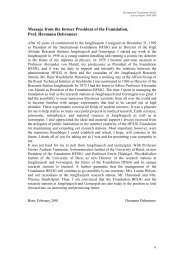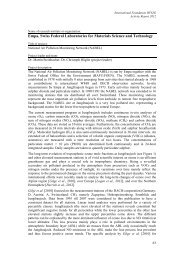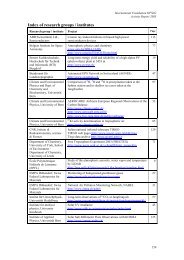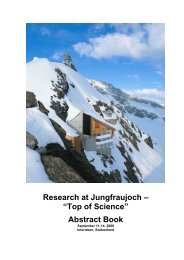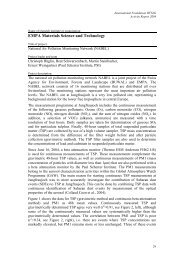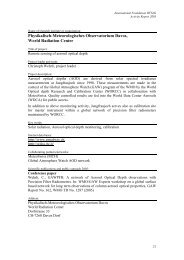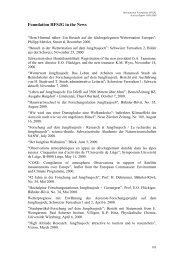Activity Report 2005 - International Foundation High Altitude ...
Activity Report 2005 - International Foundation High Altitude ...
Activity Report 2005 - International Foundation High Altitude ...
Create successful ePaper yourself
Turn your PDF publications into a flip-book with our unique Google optimized e-Paper software.
<strong>International</strong> <strong>Foundation</strong> HFSJG<br />
<strong>Activity</strong> <strong>Report</strong> <strong>2005</strong><br />
The <strong>High</strong> <strong>Altitude</strong> Research Station Gornergrat<br />
Due to its unique location, its clean environment, and the good infrastructure, the<br />
<strong>High</strong> <strong>Altitude</strong> Research Station Gornergrat, which includes the two astronomical<br />
observatories Gornergrat South and Gornergrat North as well as a container<br />
laboratory, continues to be an excellent basis for astrophysical research.<br />
Since 1974 the Astronomical Observatory Gornergrat North was subleased to the<br />
Italian Consiglio Nazionale delle Ricerche (CNR). In 1979 it was equipped with a<br />
1.5m Cassegrain-Infrared (IR) Telescope (TIRGO). The telescope and related<br />
instrumentation were run by the Istituto di Radioastronomia (IRA-CNR), sezione di<br />
Firenze, with the assistance of the Osservatorio Astrofisico di Arcetri and the<br />
Dipartimento di Astronomia e Scienza dello Spazio of the Università di Firenze. In<br />
the near-infrared wavelength range (1-2.5 micron) both images and spectra could be<br />
obtained by the camera ARNICA, while the camera TIRCAM2 allowed observations<br />
in the mid-IR regime (3-20 micron).<br />
The Observatory Gornergrat South is subleased to the Universität zu Köln. Here, the<br />
I. Physikalisches Institut der Universität zu Köln has installed the 3m radio telescope<br />
KOSMA (Kölner Observatorium für Submillimeter und Millimeter Astronomie). The<br />
central topic of the research with KOSMA, conducted jointly with the<br />
Radioastronomisches Institut, Universität Bonn, is the spectrally resolved observation<br />
of the global distribution of interstellar matter in the Milky Way and nearby external<br />
galaxies, using the important mm-, submm-lines of CO, and atomic carbon. The most<br />
advanced technical equipment combined with the excellent observing conditions at<br />
Gornergrat allow astronomical observations up to the highest frequencies accessible<br />
to ground-based instruments.<br />
Since 1998, the Space Research and Planetary Sciences Division of the University of<br />
Bern has been operating a solar neutron telescope (SONTEL) on the Belvedere<br />
plateau. This detector is the European cornerstone of a worldwide network initiated<br />
by the Solar-Terrestrial Environment Laboratory of the Nagoya University for the<br />
study of high-energy neutrons produced in energetic processes at the Sun.<br />
As already mentioned above, the year <strong>2005</strong> was a year of construction at Gornergrat.<br />
Starting in spring, the buildings that are the property of the Burgergemeinde Zermatt<br />
and the Gornergrat Bahn underwent a complete refurbishing to make the entire site<br />
more attractive for tourists and as well as for science. The Gornergrat Bahn and the<br />
Burgergemeinde Zermatt invited the <strong>Foundation</strong> to information meetings to discuss<br />
the planning. Because a universal renovation was to be carried out, all operations at<br />
Gornergrat were suspended during the summer months, i.e. no hotel, no astronomic<br />
observations. With the exception of a few interruptions, the cosmic ray experiment in<br />
the laboratory container, however, could be operated throughout the year. Gornergrat<br />
South now has newly renovated rooms and a new kitchen, and KOSMA was back in<br />
operation by the end of November <strong>2005</strong>. New rent contracts for Observatory<br />
Gornergrat South will be forthcoming for January 1, 2006. Upon the announcement<br />
of the renovation and the ensuing interruption of all operations, INAF decided that<br />
this was an appropriate time to conclude the present contract for Gornergrat North<br />
(which was due to expire <strong>2005</strong>) and to completely dismantle TIRGO. As Dr. Filippo<br />
Mannucci states in his final report (please see page 173) “the telescope had a great<br />
impact on Italian astronomy as, in the late ‘70s, it was one of the first five telescopes<br />
in the world capable of infrared observations. The development of this telescope and<br />
of its instrumentation had the consequence of creating a competitive group of infrared<br />
x



